Research Groups
- ACNM
- CRYSTALLOGRAPHY
- CMEOS
- FUNNANOSURF
- LMI
- LEEM
- LASER
- EMOLMAT
- MULFOX
- NANOMOL-BIO
- NN
- NANOPTO
- SURFACES
- SOFTMATTER
- SSC
- SUMAN
- SUSMOSYS
-
ACNM
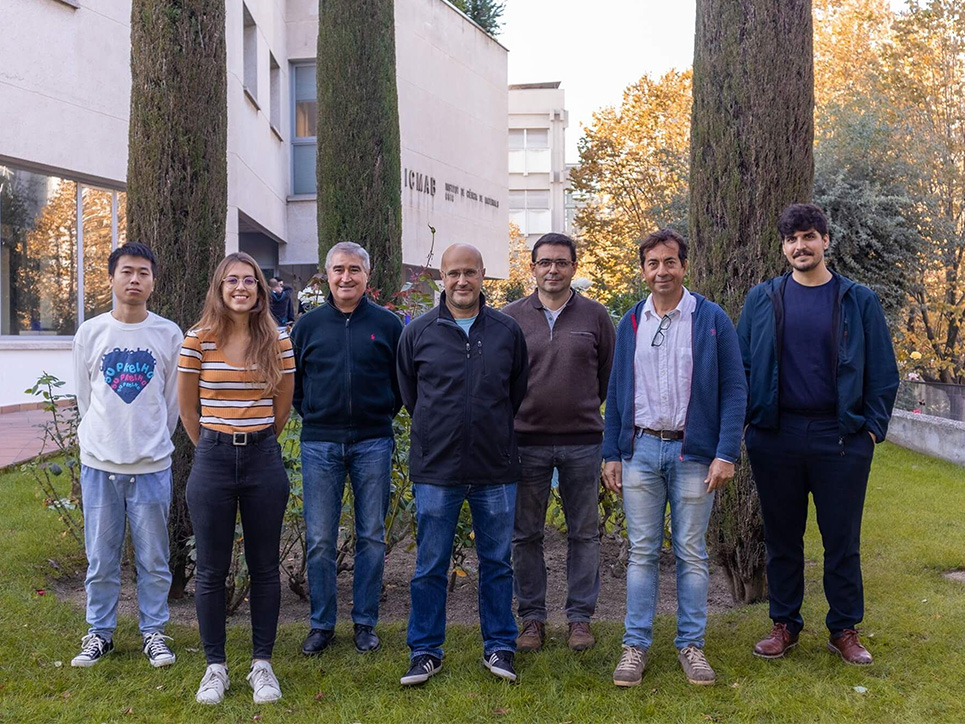 Throughout 2023, our group's primary focus has been the investigation of materials, with a particular emphasis on transition metal oxides (TMOs), for spintronics. For spintronics applications, materials must possess specific characteristics facilitating efficient manipulation and control of electron spins, which can be influenced or adjusted by microstructural and interfacial properties. Therefore, we have dedicated substantial efforts to exploring the role of microstructural defects in shaping the dynamic magnetic properties of TMOs. Furthermore, our work has extended to the study of magnetic properties at interfaces, employing local techniques such as spin Hall magnetoresistance. Additionally, we have delved into studying spin-to-charge conversion processes within TMO/normal metal (NM) heterostructures, which play a pivotal role in advancing spintronics. In this line, we have initiated investigations into the conduction of pure spin currents through antiferromagnetic oxides within all-oxide heterostructures, aiming to unlock their potential for spintronic applications.
Throughout 2023, our group's primary focus has been the investigation of materials, with a particular emphasis on transition metal oxides (TMOs), for spintronics. For spintronics applications, materials must possess specific characteristics facilitating efficient manipulation and control of electron spins, which can be influenced or adjusted by microstructural and interfacial properties. Therefore, we have dedicated substantial efforts to exploring the role of microstructural defects in shaping the dynamic magnetic properties of TMOs. Furthermore, our work has extended to the study of magnetic properties at interfaces, employing local techniques such as spin Hall magnetoresistance. Additionally, we have delved into studying spin-to-charge conversion processes within TMO/normal metal (NM) heterostructures, which play a pivotal role in advancing spintronics. In this line, we have initiated investigations into the conduction of pure spin currents through antiferromagnetic oxides within all-oxide heterostructures, aiming to unlock their potential for spintronic applications.Some examples of our work are:
- Artificial Graphene Spin Polarized Electrode for Magnetic Tunnel Junctions
Nano Letters. 23, 34-41 (2023)
Victor Zatko, Regina Galceran, Marta Galbiati, Julian Peiro, Florian Godel, Lisa-Marie Kern, David Perconte, Fatima Ibrahim, Ali Hallal, Mairbek Chshiev, Benjamin Martinez, Carlos Frontera, Lluìs Balcells, Piran R Kidambi, John Robertson, Stephan Hofmann, Sophie Collin, Frédéric Petroff, Marie-Blandine Martin, Bruno Dlubak, Pierre Seneor. - Spin-to-Charge Conversion in All-Oxide La2/3Sr1/3MnO3/SrIrO3 Heterostructures
ACS Appl. Mater. Interfaces 15, 37038−37046 (2023)
Sergi Martin-Rio, Zorica Konstantinovic, Alberto Pomar, Lluis Balcells, Javier Pablo-Navarro, M. Ricardo Ibarra, Cesar Magén, Narcis Mestres, Carlos Frontera, and Benjamin Martínez - Impact of Twin’s Landscape on the Magnetic Damping of La2/3Sr1/3MnO3 Thin Films
Adv. Mater. Interfaces, 2300882 (2023)
Shoulong Chen, Alberto Pomar, Lluis Balcells, Carlos Frontera, Narcís Mestres, and Benjamín Martínez
- Artificial Graphene Spin Polarized Electrode for Magnetic Tunnel Junctions
-
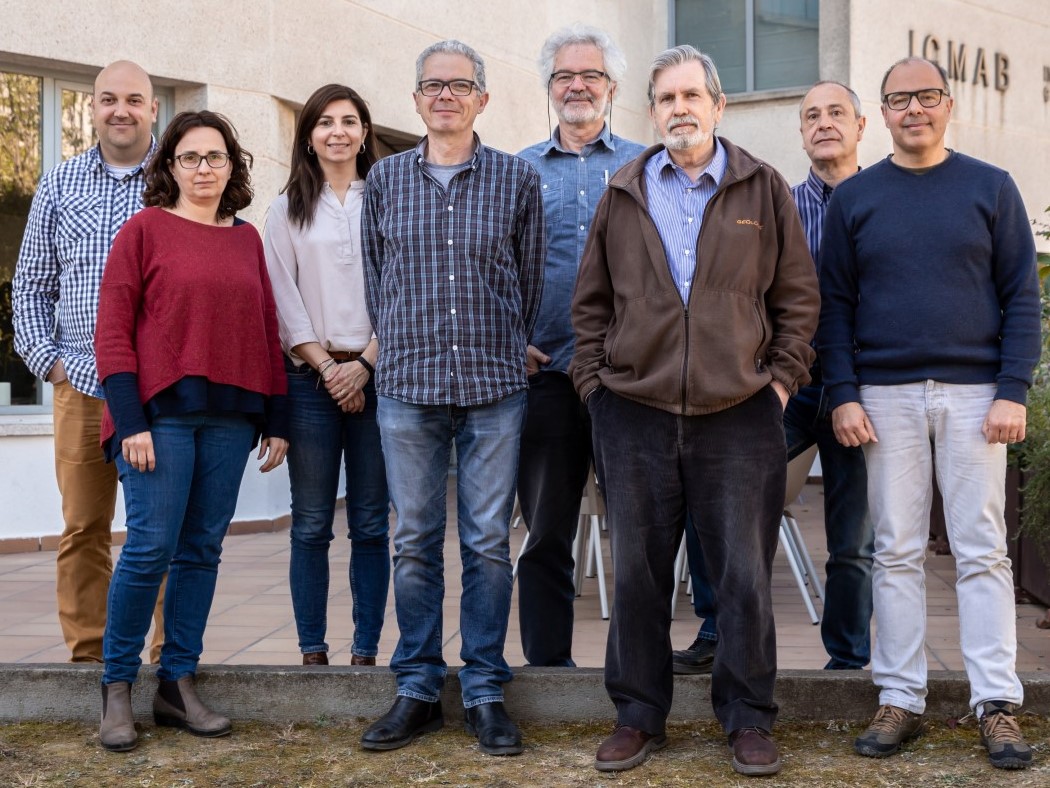
CRYSTALLOGRAPHY
The aim of the group is to explore, understand and develop new strongly correlated materials of interest in fundamental science, such as studies of intermolecular interactions, and in the improvement of methods for crystal structure determination from electron diffraction data. The group has developed the new through-the-substrate (tts) X-ray microdiffraction technique, integrated now at ALBA Synchrotron, and has a great expertise in nanocomposite porous materials, applied to different catalysis reactions.
-

CMEOS
In the Magnetic Material and Functional Oxides department at ICMAB, the activities of the Crystallography of Magnetic and Electronic Oxides and Surfaces group are addressed to explore, understand and develop new strongly correlated materials of interest in fundamental Condensed Matter research and as novel materials for the Information technologies.
-
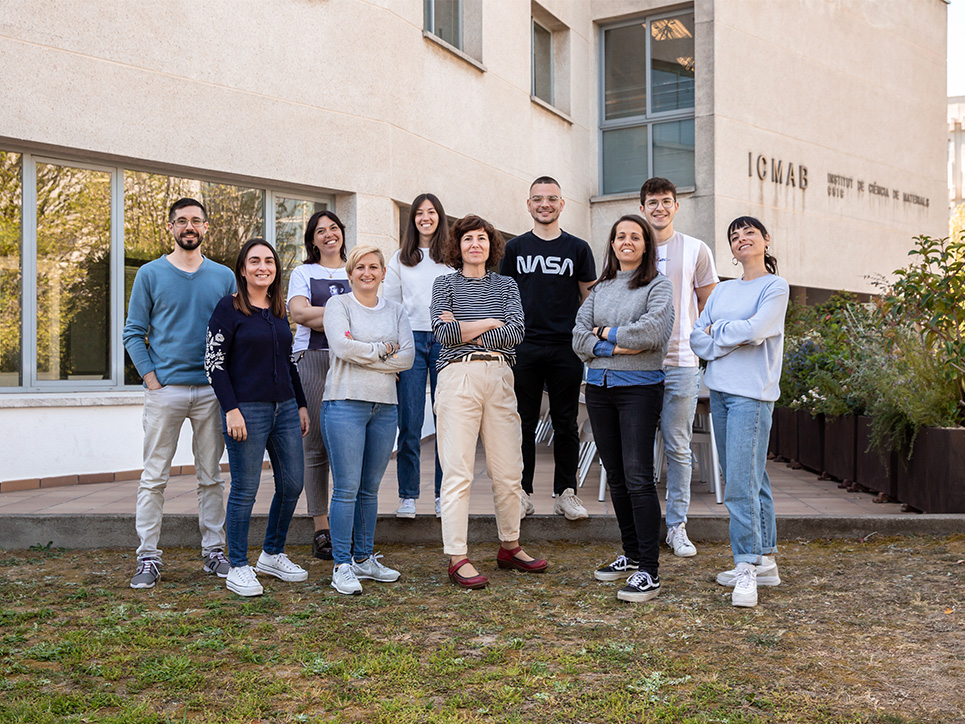
FUNNANOSURF
At FunNanoSurf, molecular design is key in our scientific strategy, with the creation of curcuminoid (CCMoid), pyrimidinic and porphyrazinic functional units, which together with methodologies to control their deposition on different substrates, give rise to responsive molecular devices, applicable in the fields of electronics, sensors and therapy-diagnostics.
This approach is perfectly illustrated by our publications and projects, (i) the study of hydrogels based on CCMoid systems (e.g. International Journal of Molecular Sciences) and (ii) our ERC-PoC "SmolSUB" which aims to optimise the systems, designed by the group, for direct deposition on substrates by vacuum.
HIGHLIGHTS
- Invited lectures by Dr. Núria Aliaga-Alcalde at the 16th European School on Molecular Nanoscience and III Congrés AMIT-CAT Dones en Nanociència I Nanotecnologia; seminar at the Faculty of Chemistry of the UB and oral communication at the XXXIX Biennial of the RSEQ.
- Oral communications by Dr. Arántzazu González-Campo and Dr. Núria Aliaga-Alcalde at the II Jornadas de Materias Avanzadas en España.
- Spanish Patent granted, 202230143 (ES-2949292_A1). ERC-PoC project, SmolSUB ("Launch of a universal Sublimation technology for molecular transfer on SUBstrates").
-
LMI
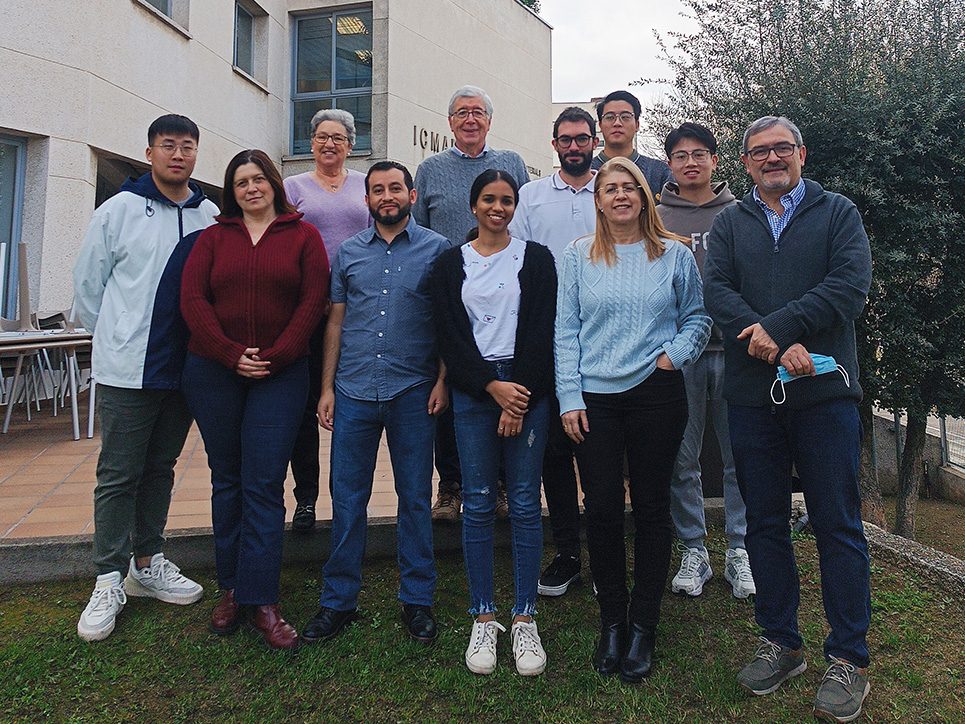 Following the group's outstanding progresses in advancing 3D aromaticity and its lengthy experimental research on halogenated boron clusters, a significant breakthrough has emerged. Contrary to expectations based on magnetic and electronic descriptors of aromaticity, along with 11B{1H}-NMR experimental spectra, it was revealed that the apparent concentric 3D/3D aromatic system is not realized. This discrepancy stems from the discovery that the evaluation of the energetic contribution of the potential double 3D-aromaticity does not contribute to the stabilization of the system. Therefore, the [B12I12](0/2+) species cannot be considered as doubly 3D-aromatic.[1] In nanomedicine, demonstrated that small metallabis(dicarbollide) molecules cross bilayer membranes in a cooperative way (DOI: 10.1039/d3cp03614f), interact with proteins (DOI: 10.1039/d3tb00816a) and possess therapeutic potential as radiosensitizers for multimodal (chemo/radio/PBFR) therapy of glioblastoma.[2] The results strongly advocate that proton boron fusion radiation (PBFR), when combined with boron-rich compounds, is a promising modality to fight against resistant tumors.[2]
Following the group's outstanding progresses in advancing 3D aromaticity and its lengthy experimental research on halogenated boron clusters, a significant breakthrough has emerged. Contrary to expectations based on magnetic and electronic descriptors of aromaticity, along with 11B{1H}-NMR experimental spectra, it was revealed that the apparent concentric 3D/3D aromatic system is not realized. This discrepancy stems from the discovery that the evaluation of the energetic contribution of the potential double 3D-aromaticity does not contribute to the stabilization of the system. Therefore, the [B12I12](0/2+) species cannot be considered as doubly 3D-aromatic.[1] In nanomedicine, demonstrated that small metallabis(dicarbollide) molecules cross bilayer membranes in a cooperative way (DOI: 10.1039/d3cp03614f), interact with proteins (DOI: 10.1039/d3tb00816a) and possess therapeutic potential as radiosensitizers for multimodal (chemo/radio/PBFR) therapy of glioblastoma.[2] The results strongly advocate that proton boron fusion radiation (PBFR), when combined with boron-rich compounds, is a promising modality to fight against resistant tumors.[2]Our research group has also achieved remarkable breakthroughs in carborane-based Metal Organic Frameworks (MOFs) research. We discovered a new technology to prepare multi-metal rare-earth multivariate (MTV) MOFs. This breakthrough enables the incorporation of various rare-earth cations in diverse combinations and ratios, opening avenues for the development of multifunctional materials with customized properties.[3] We have also reported the regioselective biomimetic photodegradation of pesticides by a Zr-based carborane MOF. [4] We explored reversible optical data storage using two-photon micropatterning in switchable materials embedded with o-carboranes. The study focuses on the application of o-carborane derivatives, allowing for precise and reversible micropatterning, thereby demonstrating potential advancements in optical data storage technologies. The research highlights the versatility of o-carboranes in creating switchable materials for two-photon processes, opening avenues for innovative data storage applications.[5]
HIGHLIGHTS
- The project "Green Phenol: one-step phenol production" was chosen for funding through CSIC's Impulsa-T call, providing vital financial support. This funding aims to assist the group of entrepreneurs in refining their concepts, tackling potential challenges, and laying a robust foundation for the establishment of a Knowledge-Based Company (EBC).
- The spin-off Labsinlove S.L. was co-founded by Dr. Rosario Núñez in collaboration with UGR groups, to develop novel anticancer drugs enriched with high boron content for effective implementation in actual human treatment through Boron Neutron Capture Therapy (BNCT).
- The project “Fluorescent boron-cluster dyes as biocompatible photosensitizers with promising antimicrobial and anticarcinogenic activity” (Ref. 101109856) led by R. Núñex has been awarded by the Horizon Europe Marie Skłodowska-Curie Actions call HORIZON-MSCA-2022-PF-01-01 with a MSCA Postdoctoral Fellowships 2022 and Seal of Excellence
[1] J. Poater, S. Escayola, A. Poater, F. Teixidor, H. Ottosson, C. Viñas and M. Solà, J. Am. Chem. Soc., 2023, 145(41), 22527. Cover of the issue.
[2] M. Nuez-Martínez, M. Queralt-Martín, A. Muñoz-Juan, V.M. Aguilella, A. Laromaine, F. Teixidor, C. Viñas, C.G. Pinto, T. Pinheiro, J.F. Guerreiro, F. Mendes, C. Roma-Rodrigues, P.V. Baptista, A. R. Fernandes, S. Valic and F. Marques. J. Mater. Chem. B, 2022, 10, 9794. Cover of the issue and selected by the journal's editors to be one of the 30 articles featured in the 2022 collection of most popular articles.
[3] Z. Li, X.-B. Li, M. E. Light, A. E. Carrillo, A. Arauzo, M. Valvidares, C. Roscini, F. Teixidor, C. Viñas, F. Gándara, E. Bartolomé and J. G. Planas, Adv. Funct. Mater., 2023, 33, 2307369.
[4] L. Gan, M. T. Nord, J. M. Lessard, N. Q. Tufts, A. Chidambaram, M. E. Light, H. Huang, E. Solano, J. Fraile, F. Suárez-García, C. Viñas, F. Teixidor, K. C. Stylianou and J. G. Planas, J. Am. Chem. Soc., 2023, 145, 13730–13741.
[5] S. Abdallah, R. Mhanna, J. Cabrera-González, R. Núñez, A. Khitous, F. Morlet-Savary, O. Soppera, D.-L. Versace and J.-P. Malval. Chem Mater. 2023, 35 (17), 6979-6989 -
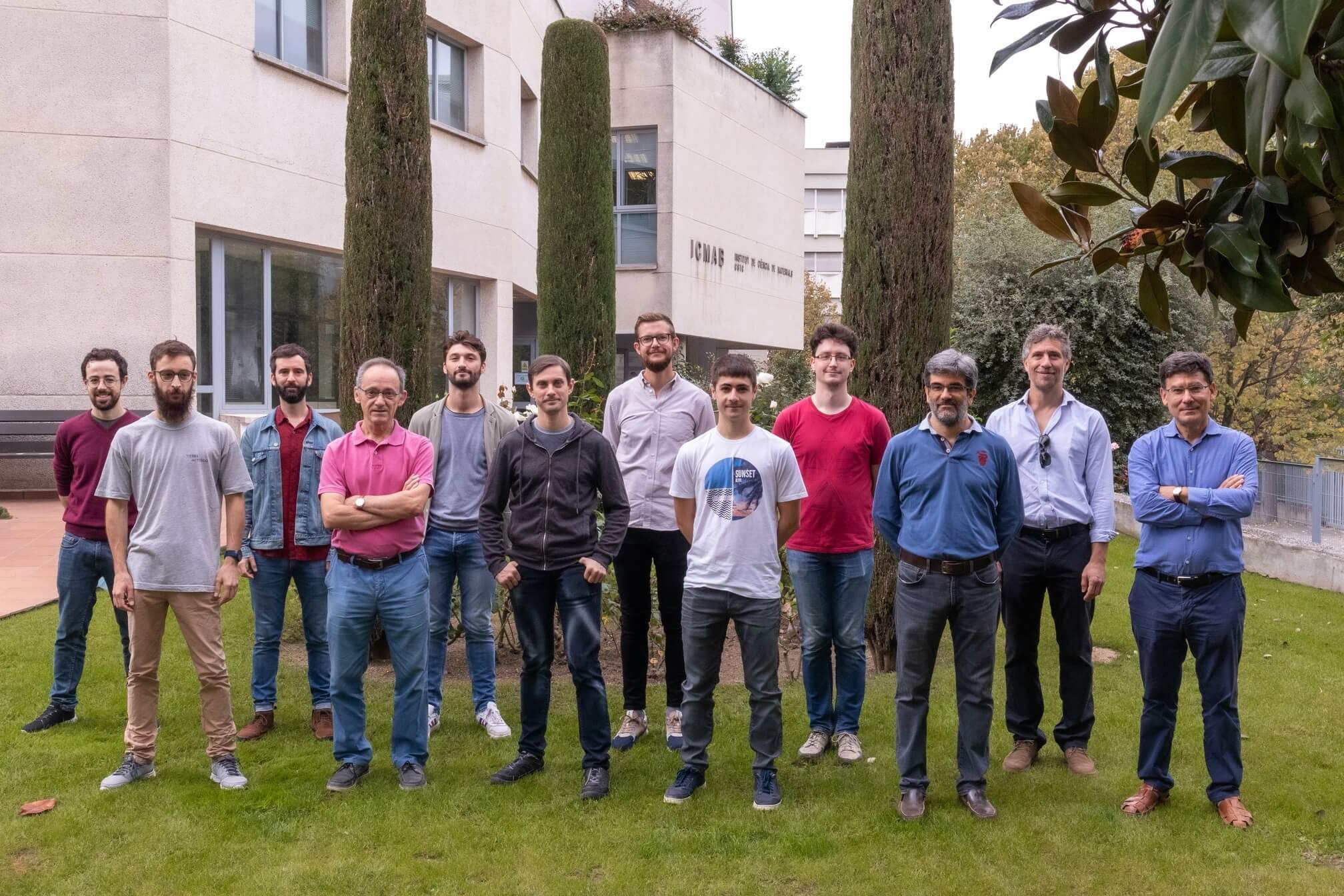
LEEM
The strategic lines of the Theory and Simulation Group are the simulation of soft-matter, novel functionalities in oxide-based systems, flexoelectricity, thermal transport, electronic and vibrational instabilities in low-dimensional systems and the development and applications of ab-initio simulation codes
SCIENTIFIC HIGHLIGHTS
- In-Plane Flexoelectricity in Two-Dimensional Crystals
M Springolo, M Royo, M Stengel
Physical Review Letters 131 (23), 236203 - Accurate Prediction of Hall Mobilities in Two-Dimensional Materials through Gauge-Covariant Quadrupolar Contributions
S Poncé, M Royo, M Gibertini, N Marzari, M Stengel
Physical Review Letters 130 (16), 166301 - How to verify the precision of density-functional-theory implementations via reproducible and universal workflows
E Bosoni, L Beal, M Bercx, P Blaha, S Blügel, J Bröder, M Callsen, ...
Nature Reviews Physics, 1-14 - Structural Approach to Charge Density Waves in Low-Dimensional Systems: Electronic Instability and Chemical Bonding
JP Pouget, E Canadell
Reports on Progress in Physics - Interplay Between Doping, Morphology, and Lattice Thermal Conductivity in PEDOT: PSS
PS Floris, C Melis, R Rurali
Advanced Functional Materials, 2215125
- In-Plane Flexoelectricity in Two-Dimensional Crystals
-
LASER
 The activities of the group were mainly dedicated to the fabrication of hybrid carbon-based nanocomposites for energy storage and solar water splitting applications by means of advanced laser technologies:
The activities of the group were mainly dedicated to the fabrication of hybrid carbon-based nanocomposites for energy storage and solar water splitting applications by means of advanced laser technologies:(i) Hybrid supercapacitor electrodes constituted by nanostructured carbon-metal oxides were developed by crystallizing pseudocapacitive metal-oxide nanoparticles on the surface of the carbon nanostructures. Two approaches were used: (a) Laser deposition by the Reactive Inverse Matrix Assisted Pulsed Laser Evaporation (RIMAPLE) method, consisting on the irradiation of frozen aqueous dispersions of graphene oxide (GO), carbon nanotubes (CNT), and transition metal precursors in order to induce the simultaneous chemical transformation of the reactants and the deposition of electrochemically active reduced GO-CNT-metal oxide composites. The mechanisms responsible for the charge storage were thoroughly studied by advanced characterization techniques. (b) Laser surface processing of nanocarbon-precursor films for inducing the crystallization of pseudocapacitive nanoparticles on the nanocarbons’ surface. The obtained hybrid electrodes revealed significantly increased capacitance as compared to their counterpart electrodes composed of just carbon. Thorough works for functional properties optimization and scaling up of the electrodes fabrication to large areas was carried out with the aim to get this technology closer to industrial standards.
(ii) Liquid phase laser synthesis of hybrid graphene-based photocatalysts for solar water-splitting hydrogen production. Noble-metal-free photocatalyst powders were obtained by laser irradiation of aqueous graphene oxide-metal organic precursor dispersions. The laser radiation promotes the concurrent reduction of the graphene oxide and its decoration with semiconducting metal oxide nanostructures leading to an enhanced hydrogen generation quantum yield.
Highlights
1. Article:
“Functional enhancement of laser deposited carbon-based supercapacitor electrodes upon post-annealing treatment”, Angel Pérez del Pino, Pablo García Lebière, Alifhers Mestra, Enikö György,Carlos García López, Wolfgang Bacsa, Constantin Logofatu, Ceramics International 49 (2023) 33469-33479
2. Registration of two industrial secrets related to the laser fabrication of supercapacitor electrodes.
-
EMOLMAT
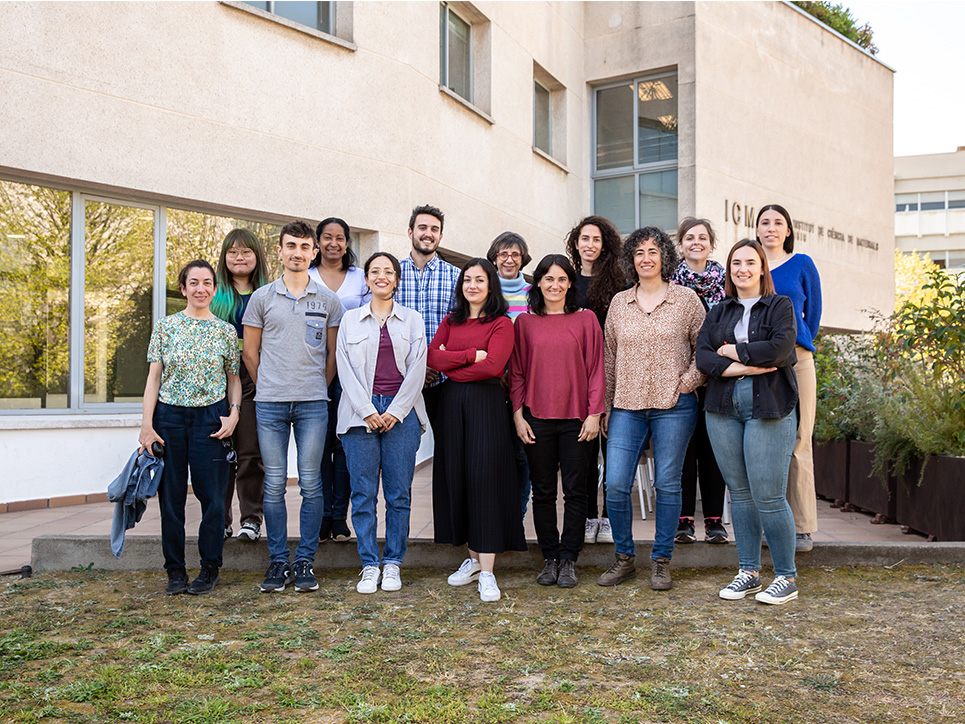 The e-MolMat group has been working on the performance optimisation of organic field-effect transistors (OFETs) prepared by a low-cost solution process. In particular, contact doped devices have been fabricated in order to reduce the contact resistance. This was realised by inserting a dopant layer between the OSC and the top gold contacts. However, this methodology leads to dopant diffusion towards the OFET channel hampering the device performance. We demonstrated that the dopant diffusion can be controlled by blending the OSC with polystyrene of high molecular weight, giving rise to OFETs revealing a higher mobility and stability.
The e-MolMat group has been working on the performance optimisation of organic field-effect transistors (OFETs) prepared by a low-cost solution process. In particular, contact doped devices have been fabricated in order to reduce the contact resistance. This was realised by inserting a dopant layer between the OSC and the top gold contacts. However, this methodology leads to dopant diffusion towards the OFET channel hampering the device performance. We demonstrated that the dopant diffusion can be controlled by blending the OSC with polystyrene of high molecular weight, giving rise to OFETs revealing a higher mobility and stability.Further, the prepared OFETs have been applied for sensing applications. In our recent work, we reported a robust electrolyte-gated OFET able to respond to pH in the range 1–10. This was realized by exploiting the pH-dependent supramolecular host–guest complexation taking place between imidazole and β-cyclodextrin (β-CD). The sensing protocol was performed by incubating magnetic nanoparticles functionalized with β-CD with imidazole solutions at different pHs and trapping them in a magnetic carbon electrode. Such an electrode was then implemented as gate contact in the device.
Considering molecular-based electronics, the preparation of monolayers based on an organic radical has been pursued on H-terminated silicon surfaces. Using a liquid metal to top contact the monolayers, metal/monolayer/semiconductor junctions have been investigated as diodes. The junctions incorporating the radical compared with junctions formed using a closed-shell monolayer analogous, displayed an almost two orders of magnitude higher rectification ratio and a 4-fold increase of the photosensitivity under irradiation. This was ascribed to the influence of the singly occupied and unoccupied SOMO-SUMO molecular orbitals in the radical junctions on the charge transport.
Highlights
- Dopant diffusion inhibition in organic field-effect transistors using organic semiconductor/high-molecular-weight polymer blends.
J. Li, E. Colantoni, I.Temino, P. Branchini, L. Tortora, M. Mas-Torrent, Chemistry of Materials 2023, 35, 1527. - pH Sensor based on supramolecular host–guest interactions and an organic field-effect transistor with a magnetic carbon gate electrode.
A. Tamayo, A. Campos-Lendinez, J. Muñoz, N. Crivillers, M. Mas-Torrent, Chemistry of Materials 2023, 5, 21, 9257. - Stable organic radical for enhancing metal-monolayer-semiconductor junction performance.
J. A. De Sousa, R. Pfattner, D. Gutierrez, K. Jutglar, S. T. Bromley, J. Veciana, C. Rovira, M. Mas-Torrent, B. Fabre, N. Crivillers, ACS Appl. Mater. & Interf. 2023, 15, 4635.
- Dopant diffusion inhibition in organic field-effect transistors using organic semiconductor/high-molecular-weight polymer blends.
-
MULFOX
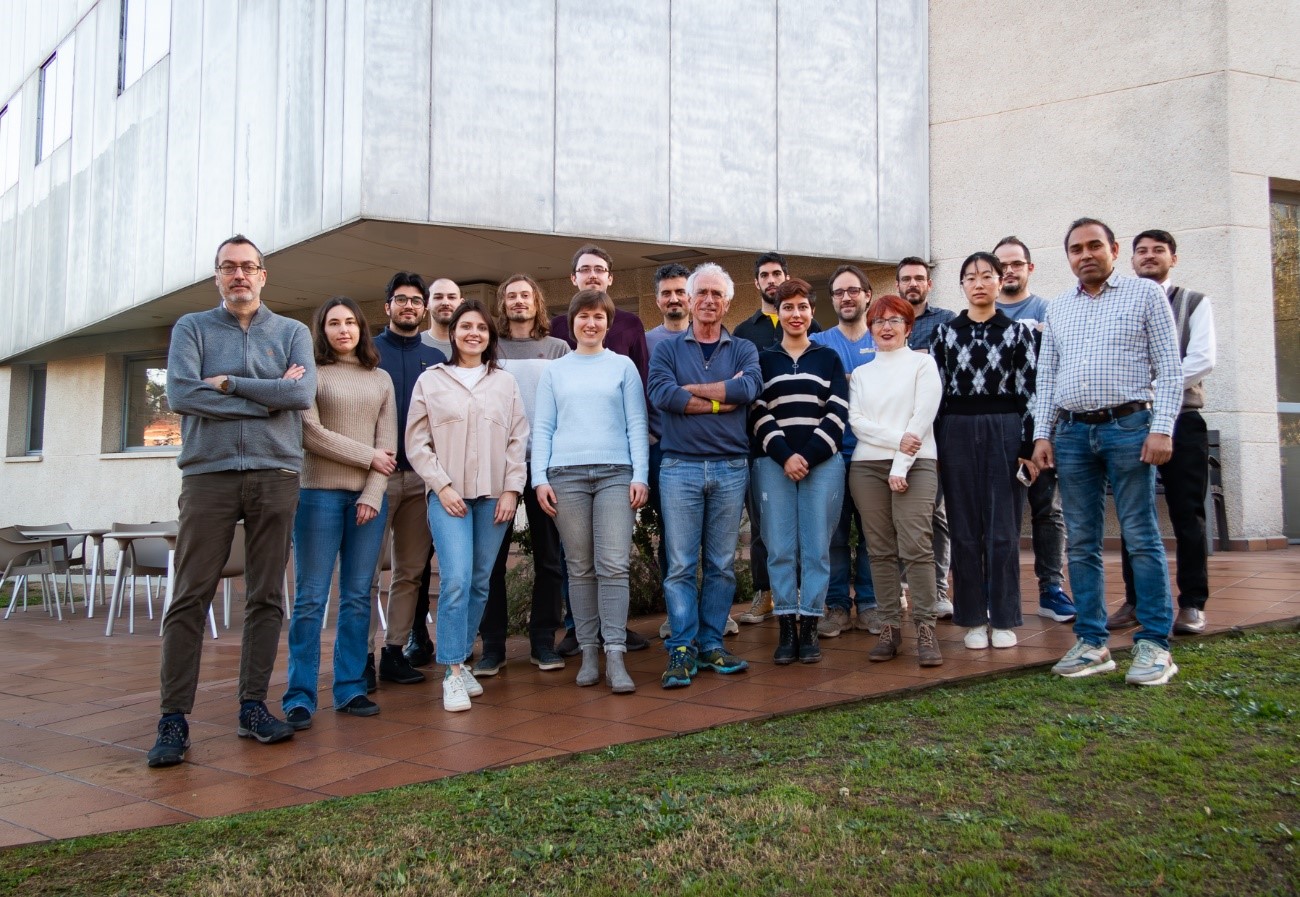 MULFOX has continued a fruitful research on oxide thin films with prospects for emerging applications. Our research involves unraveling the impacts of manipulating atomic structure and composition on the physical properties of oxides. Hence, we seek to establish intricate relationships between the structure, chemistry, and physical characteristics of oxide nanostructures.
MULFOX has continued a fruitful research on oxide thin films with prospects for emerging applications. Our research involves unraveling the impacts of manipulating atomic structure and composition on the physical properties of oxides. Hence, we seek to establish intricate relationships between the structure, chemistry, and physical characteristics of oxide nanostructures.Within the context of magnetism and spintronics, we disclosed that early 3d transition metals, in spite of having a negligible spin-orbit coupling, may display an unexpected spin absorbing capability, which suggest new avenues for spintronics, probably related to orbital currents rather than spin currents. A variety of projects are currently being developed, going to unveil the elusive orbital currents.
We have continued developing insulating and conducting ferri/ferromagnetic thin film heterostructures for a wide range of spintronic device applications. Recent highlights include the development of Tb3Fe5O12 thin films down to 3 nm of thickness with tunable magnetic properties, devising a novel methodology for spin-torque characterization in magnetic insulator-based devices, and demonstration of magnetoresistive detection of the perpendicular switching in a magnetic insulator by means of spin valve effect. In parallel, we have continued work on the spin caloritronic effects in Y3Fe5O12/Pt and Fe/Pt layered structures to enhance the thermoelectric output power and explore new physics at the intersection of heat, charge and spin currents.
The interaction of light-matter is an emerging activity encompassing the exploration of the photo-response of Jahn-Teller polarons, including detailed quantum-mechanical modeling of their spin orbit-related spectral response, as well a detailed understanding of the photoresponse of non-centrosymmetric materials (Bulk Photovoltaic Effect) and the complex interplay among different contributions to the light-polarization dependence of their photoresponse and engineered materials with large responsivities at visible range.
The significance of reduced dimensionality, interfases and defects play a pivotal role in determining macroscopic material properties. To get insight, we use cutting-edge electronic microscopy techniques based on aberration-corrected scanning transmission electron microscopy (STEM) and electron energy loss spectroscopy (EELS).
Last, we have largely collaborated with other groups within ICMAB to understand the beautiful properties of uncommon oxynitrides and other unique materials and the phonon processes contributing to the response of cryogenic sensors for low-mass dark matter detection and explored spintronic properties of high Tc superconductors.
HIGHLIGHTS
- Untwining polar contributions from light-polarization dependent photovoltaic response of LuMnO3-based ferroelectric capacitors
Y. Sheng et al. Acta Materialia, 245, 118601, 2023
- Band Alignment and Photoresponse of LaFeO3-Based Heterojunctions
Yunwei Sheng, Mathieu Mirjolet, Mario Villa, Jaume Gàzquez, José Santiso, Andreas Klein, Jordi Fraxedas, and Josep Fontcuberta
Phys. Rev. Applied 19, 024001 (2023) - Leveraging symmetry for an accurate spin-orbit torques characterization in ferrimagnetic insulators
Testa-Anta et al., Adv. Electron. Mater. 9, 2300044 (2023)
- Untwining polar contributions from light-polarization dependent photovoltaic response of LuMnO3-based ferroelectric capacitors
-
NANOMOL-BIO

NANOMOL-BIO is devoted to the synthesis, physico-chemical characterization and development, up to pre-clinical regulatory phases, of molecular and polymeric (nano)materials for biomedicalapplications. The molecuar materials that we develop, are always validated in the frame of collaborations with national and international research groups allocated in hospitals or in biomedical research centers. An important collaborative EU project started this year and coordination by our group is Nabiheal project (https://www.nabiheal.eu/), devoted to the development of metal-free biomaterials with antimicrobial properties for the treatment of complex wounds. A project from La Caixa Foundation has also been awarded to work on chiral photocatalytic nanozymes. We belong to CIBER network (https://www.ciberisciii.es/), as many of our collaborators and our intensive technology transfer activity has the TECNIO recognition (https://tecnio.org/) given by ACCIO Agency of the Catalan government.
Our activity within 2023 was principally focused on:
1) Nanovesicles for biomedical applications: In collaboration with experts in the development of optical probes and photodynamic therapy, we have expanded the applicability of highly stable fluorescent quatsomes developed in our group (Pharmaceutics: DOI: 10.3390/pharmaceutics15030902; DOI: 10.3390/pharmaceutics14112498). We are eager to announce that the EC has granted through EIC Transition project Nano4Rare (ID: #101136772), the completion of the preclinical testing of a nanomedicine candidate for Fabry disease, developed and patent protected by our group, till the arrival to “First in human approval”. In parallel, new knowledge on the supramolecular organization of the non-liposomal quatsomes nanovesicles has been generated (JCIS: DOI: 10.1016/j.jcis.2022.10.104)
2) Development of surface coating strategies using multifunctional biomaterials to prevent infections in the framework of the project “FUNCATH: Prevention of vascular catheter-related infections by the functionalization of catheters with self-assembled monolayers with antimicrobial agents of broad spectrum” in collaboration with Hospital Clinic (Barcelona); Hospital Taulí and IRTA, and financed by La Marató TV3. We published three papers in collaboration; Pharmaceutics (Doi: 10.3390/pharmaceutics15041068), Front. Bioeng. Biotechnol. (Doi:10.3389/fbioe.2023.1173260) and Mater. Adv. (Doi:10.1039/D2MA00978A)
3) Imaging applications of organic radical systems: Radical dendrimers as metal-free contrast agents in magnetic resonance imaging (MRI) and development of bimodal fluorescent-magnetic imaging probes. Projects: “VIRADEN: In vivo Studies of Radical Dendrimers as Contrast Agents for Magnetic Resonance Imaging, SO FIP-2020”, and “Radical-NEED: Radical Dendrimers as New Metal-free MRI Contrast Agents for Glioblastoma Diagnosis. CIBER-BBN project” in collaboration with GABRMN group at UAB.
4) Development of biomimetic 3D hydrogels for cancer-related applications in collaboration with different (pre)clinical settings including Hosp. Clinic de BCN and Vall d’Hebron Institute of Oncology. Projects: “Development of Patient-Derived Organoids based on Lymph Node-inspired 3D Hydrogels as Hematological Cancer Model” (SO FIP-2021), “Patient Derived Organoids 2.0” (CIBERONC), and “Lymph node-inspired 3D printed hydrogels for adoptive cell therapy” (CIBER-BBN).
Highlights:
- Nanothermometer based on a radical eximer for in vivo sensing in the biological transparency window.
(i) “Ratiometric Nanothermometer Based on a Radical Excimer for In Vivo Sensing”. D. Blasi, N. Gonzalez-Pato, X. Rodriguez Rodriguez, I. Diez-Zabala, S. Yasaswini Srinivasan, N. Camarero, O. Esquivias, M. Roldán, J. Guasch, A. Laromaine, P. Gorostiza, J. Veciana, I. Ratera; Small 2023, 2207806. Doi: 10.1002/smll.202207806; (ii) “Nanothermometer Based on Polychlorinated Trityl Radicals Showing Two-Photon Excitation and Emission in the Biological Transparency Window: Temperature Monitoring of Biological Tissues”. N. Gonzalez-Pato, D. Blasi, Domna M. Nikolaidou, F. Bertocchi, J. Cerdá, F. Terenziani, N. Ventosa, J. Aragó, A. Lapini, J. Veciana, I. Ratera; Small Methods 2023, 2301060. Doi: 10.1002/smtd.202301060. - Dendrimers with fluorescent and magnetic properties as bimodal imaging probes.
“Fluorescent and Magnetic Radical Dendrimers as Potential Bimodal Imaging Probes.” S. Zhang, V. Lloveras, Y. Wu, J. Tolosa, J. C. García-Martínez, J. Vidal-Gancedo. Pharmaceutics 2023, 15, 1776. Doi:10.3390/pharmaceutics15061776. - Development of biomimetic 3D hydrogels for cancer-related applications. “3D cell culture of CAR T cells originated from peripheral blood mononuclear cells towards cellular therapies”. E. Pérez del Río, M. Román Alonso, I. Rius, F. Santos, M. Castellote-Borrell, J. Veciana, I. Ratera, J. Arribas, J. Guasch. Cytotherapy 2023, 25(12), 1293. DOI: 10.1016/j.jcyt.2023.08.003
- Supramolecular organization of the non-liposomal quatsomes nanovesicles. “Stable nanovesicles formed by intrinsically planar bilayers”
M. Köber, S. Illa-Tuset, L. Ferrer-Tasies, E. Moreno-Calvo, W. I Tatkiewicz, N. Grimaldi, D. Piña, A. Pérez Pérez, V. Lloveras, J. Vidal-Gancedo, D. Bulone, I. Ratera, J. Skov Pedersen, D. Danino, J. Veciana, J. Faraudo, N. Ventosa. J Colloid Interface Sci 2023, 631(Pt A):202-211; doi: 10.1016/j.jcis.2022.10.104.
- Nanothermometer based on a radical eximer for in vivo sensing in the biological transparency window.
-
NN
 The research line on the evaluation of new molecules and nanomaterials in the C. elegans organism has had an intensive publishing activity, working hand in hand with old and new collaborators. We evaluated the conductive polypyrrole nanoparticles produced in-house. With collaborators at the ICMAB; we studied metallacarboranes with the group of Prof. C. Viñas and ratiometric fluorescent nanothermometers with the group of Dr. Imma Ratera. Together with Prof. N. Ventura's group, we assessed polystyrene nanoparticles. Additionally, we published the scope of the recent European project awarded, NEXTGEM, where 5G fields are screened with C. elegans.
The research line on the evaluation of new molecules and nanomaterials in the C. elegans organism has had an intensive publishing activity, working hand in hand with old and new collaborators. We evaluated the conductive polypyrrole nanoparticles produced in-house. With collaborators at the ICMAB; we studied metallacarboranes with the group of Prof. C. Viñas and ratiometric fluorescent nanothermometers with the group of Dr. Imma Ratera. Together with Prof. N. Ventura's group, we assessed polystyrene nanoparticles. Additionally, we published the scope of the recent European project awarded, NEXTGEM, where 5G fields are screened with C. elegans.The research line on natural polymers has grown in the use of bacterial cellulose (BC) fibers, Cell-laden 3D hydrogels of type I collagen incorporating bacterial nanocellulose fibers, together with the group of Jordi Otero and Cellulose‑in‑cellulose 3D‑printed bioaerogels for bone tissue engineering, a collaboration lead by Carlos Garcia’ Group. As well as on novel BC nanocomposites; Ce1−xZrxO2 nanoparticles in bacterial cellulose with self-regenerating antioxidant capabilities and Conductive bacterial nanocellulose-polypyrrole patches promote cardiomyocyte differentiation. The collaboration with the Barraquer Clinics on the investigation of new ophthalmologist treatments is advancing at a good speed. A joint clinical trial with healthy volunteers started in 2023.
Our proprietary technology co-developed with the CNM on electrochemical sensors for on-site analysis of water contaminants, is being well received by the water sector. We have taken important steps to create a spin-off company to exploit this technology.
Finally, we extended and consolidated our activities in the synthesis of high-quality nanoparticles for several applications, including hydrogen production. We have also set up a laboratory for the synthesis and characterization of nanoparticles for magnetic hyperthermia.
Highlights:
- Congratulations to Pablo Guardia, a RyC fellow in our group, who has secured a Tenured Scientist position! His scientific activity will support RL2, Materials for Energy.
- Several projects have been granted from various funding agencies: 2023 has been a good year for the NN Group!
- ERC-Proof of Concept; Filling the gap in 5G and 6G wireless communication technologies (Pi4NoRM).
- Fundació La Marató; Administració endovascular de nanomaterials terapèutics per a la recuperació de l’ictus (End-STROKE).
- Ministerio de Ciencia e Innovación; Novel nano heterostructures for the exploitation of magneto- and photo-hyperthermia in wireless power transfer technologies and its application in energy and catalysis (CNS2022-135583 HYPE-POWER).
- CSIC Impulsa-T; Materiales para tratamientos oftalmológicos (Mat-Oftal).
- Generalitat de Catalunya-SGR; Nanoparticle and Nanocomposites Group.
- Our students keep rocking it!
- Sumithra Y. Srinivasan (5th July 2023) defended her Ph.D. Thesis “Polypyrrole Nanoparticles & Composites: Cardiac Arrhythmia Treatment Evaluated in Cells & Caenorhabditis elegans” with flying honors!
- Amanda Muñoz Juan (16th Jan 2024) defended her Ph.D. Thesis “Assessment of Bacterial nanocellulose on Caenorhabditis elegans” with excellent cum laude mark.
- Sole Roig, who did her Doctoral Thesis entitled “Novel bacterial cellulose materials: Structuration, functional nanocomposites and photocurable hydrogels” in our group, received the CSIC Relevant Doctoral on its first edition.
- Master’ students Allan Lancézeux, Pablo Rodríguez, Lisa Ponsi, and Victor Lestriez obtained the highest marks for their MSc. Thesis.
-
NANOPTO
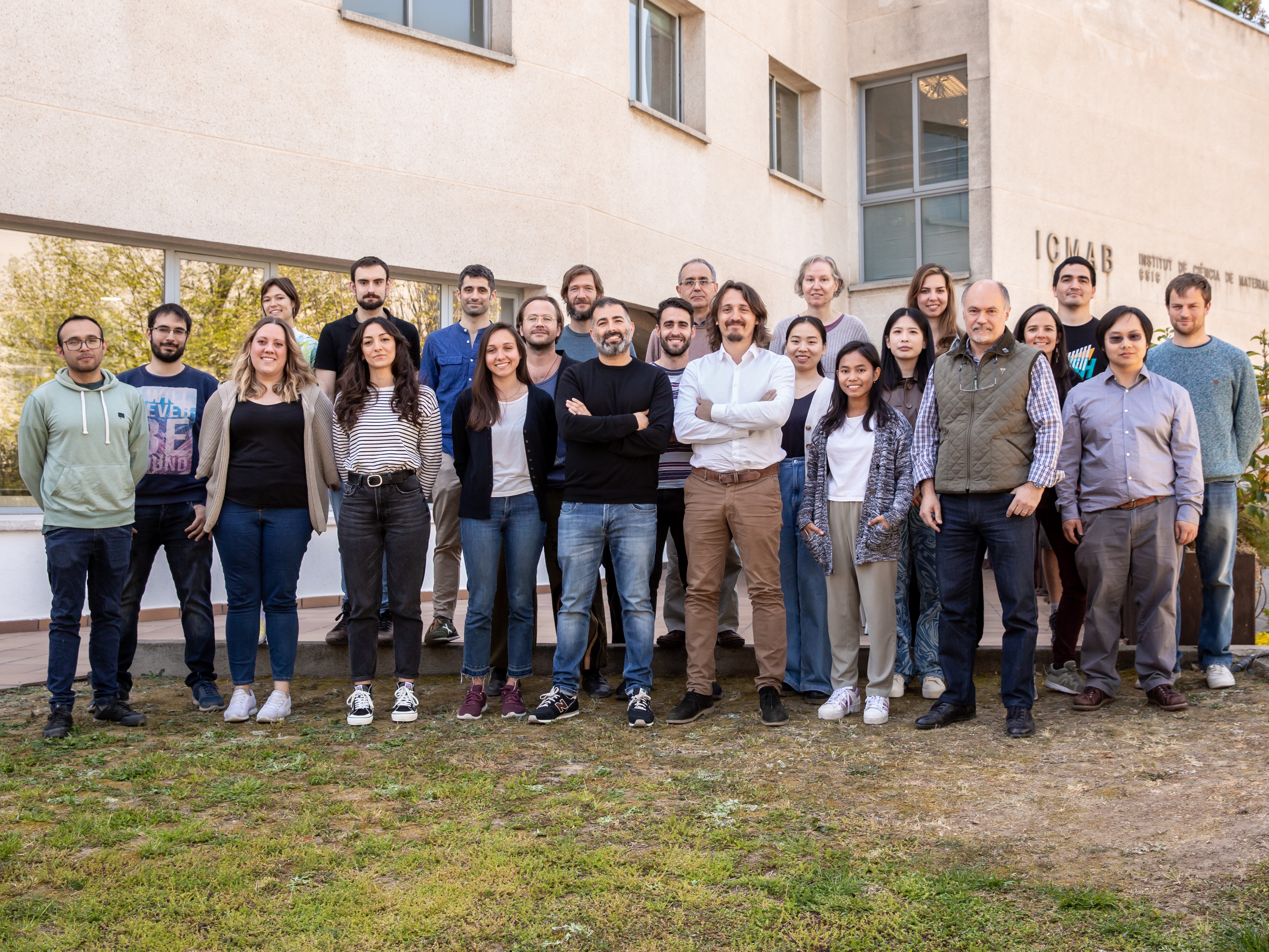 Our group achieved great progresses in a number of research areas in 2023. Our achievements are an evidence to our dedication to expanding scientific understanding and creating technology with practical uses.
Our group achieved great progresses in a number of research areas in 2023. Our achievements are an evidence to our dedication to expanding scientific understanding and creating technology with practical uses.In Organic Photovoltaics, research published on Advanced Materials explores an alternative spectral splitting device concept in which various individual semiconducting junctions with cascading bandgaps are laid side by side (RAINBOW solar cell concept). This year we have also contributed to the field of agrivoltaics with a publication on Advanced Functional Materials in collaboration with Prof. Olle Inganäs (Linkoping, Sweden).
In Thermoelectrics, we have published the research on the International Journal of Heat and Mass Transfer of an innovative contactless method suitable to study in-plane thermal transport based on beam-offset frequency-domain thermoreflectance using a one-dimensional heat source with uniform power distribution; and we have also collaborated on the research published on Vacuum on the thermal conductivity of ZnO and ZnO:Al thin films.
In the Photonic Architectures for Light Management research line, the work published on ACS Applied Materials & Interfaces shows high Q-factors (Q > 250) for plasmonic SLRs sustained by plasmonic crystals constituted by colloidal gold NP clusters. Moreover, we have also demonstrated in a publication on Advanced Materials large area CPL-active halide perovskite NCs chiral structures using template-induced self-assembly. Finally, the research published on Advanced Optical Materials demonstrates the use of a low-cost, versatile, and highly scalable technique such as template-assisted self-assembly for the preparation of high-quality plasmonic-based metasurfaces to promote nonlinear optical emission phenomena.
In the field of perovskites, two publications are worth mentioning: the first one in an invited special issue on Scientific Reports to deepen our fundamental understanding of metal halide perovskites under high pressure, and the second one published on The Journal of Physical Chemistry C (including cover) where we investigate the electron-phonon interaction in perovskites.
We point out our recent patents: a new contactless method for the measurement of thermal conductivity in materials (P202130821); a patent (EP1641.1923) in collaboration with Dr. Alexandre Ponrouch regarding thermoelectrics and batteries; and a new device and method for thermal diffusivity analysis (EP23382418.4 / EP1641.1861).
HIGHLIGHTS
- The spin-off Molecular Gate, S.L. (founded by Mariano Campoy Quiles and Aleksandr Perevedentsev) has raised a second round of funding.
- Project Ref. PID2022-141956NB-I00, Photonic Architectures to improve light outcoupling in Light emitting layers (OUTLIGHT) led by Agustín Mihi and Mª Isabel Alonso was granted by MICINN at the call “Proyectos de Generación de Conocimiento”.
- The SOLS device, behind the patent ES1641.1760 “Spectral shaper illumination device”, has been awarded the 1st Prize in the “Premis EmErgEnt” from the Efficient Energy Cluster in Catalunya (Clúster de l’Energia Eficient de Catalunya) and also has reached the Top 10 finalist in the Premio Ideas Innovadoras Isabel P. Trabal from Fundación Caja de Ingenerios.
- Sergi Riera-Galindo has obtained a permanent position within the framework of the “Científico Titular” in organic electronics and its applications at Nanopto group.
- Bernhard Dörling has obtained a permanent position within the framework of the “estabilización de personal laboral fijo, Doctor Fuera de Convenio” to work in thermoelectrics at Nanopto group.
-
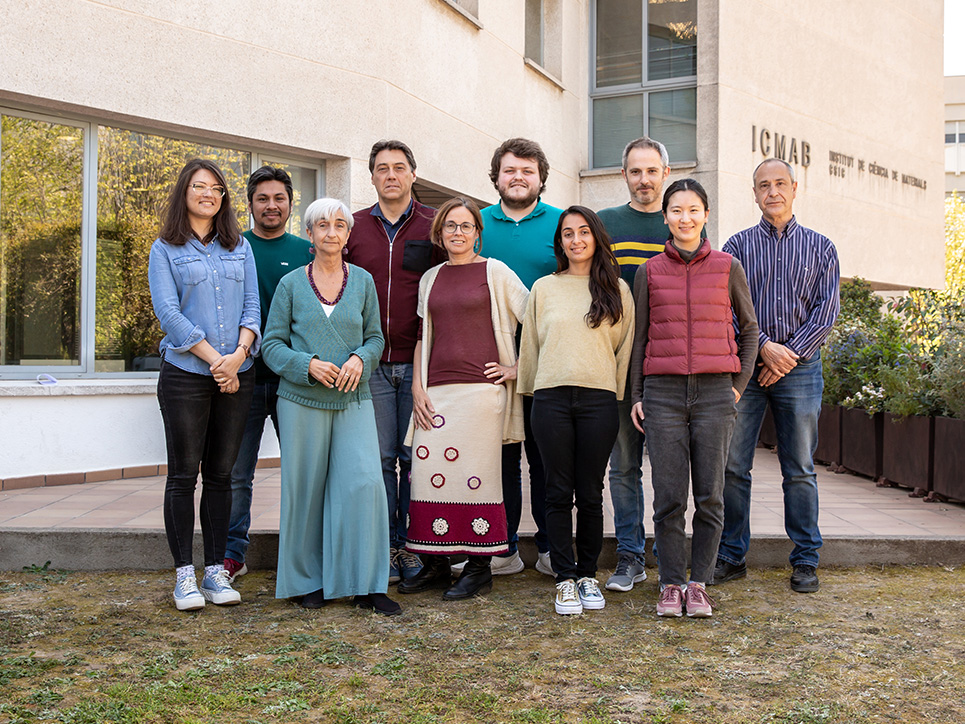
SURFACES
Focused on unraveling and controlling the nanoscale structural and electronic properties of nanostructures and interfaces through surface engineering. Devoting special effort to organic materials, part of our investigation centers on organic semiconductors with relevance as active layers for electronic devices (such as organic solar cells and organic field effect transistors).
Our research spans from fundamental issues in organic growth to the electronic response of metal-organic junctions within two main research activities:
- Design and growth of ultrathin organic layers and organic/organic heterojunctions and
- Nanoscale properties of organic/electrode interfaces and devices
-
SOFTMATTER
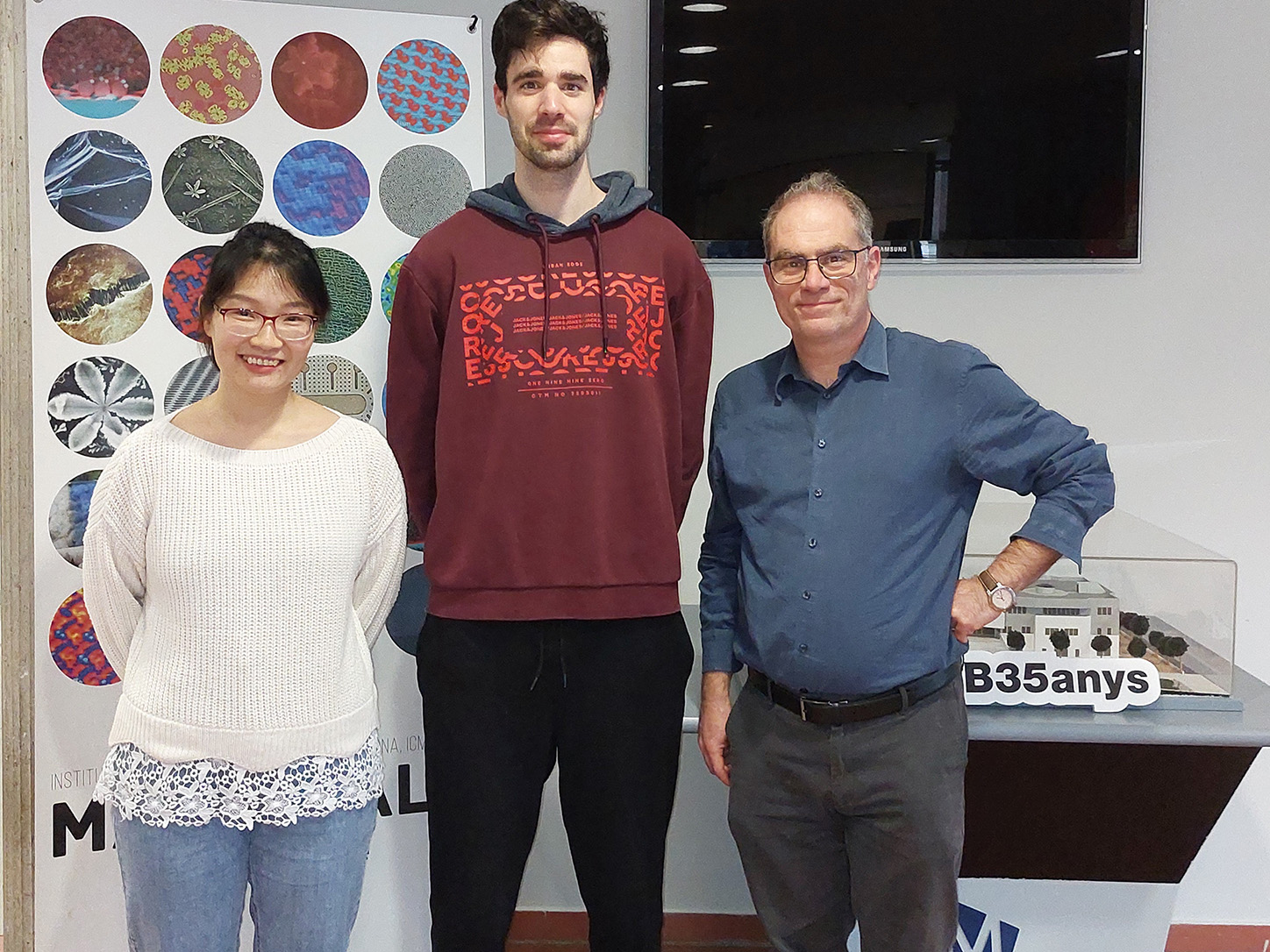 The SoftMatter Theory group combines different theoretical approaches and simulation techniques to study materials made by building blocks with mutual interactions that have energies of the order of the thermal energy (they are therefore easily deformed, hence the term “softmatter”). Our interests include thermoresponsive polymers, magnetic dispersions, (bio)functionalized nanoparticles, biopolymers, hydrogels and self-assembled structures (vesicles, liposomes, membranes). We have also a special interest in the interaction between biomolecules and materials and biomimetic materials.
The SoftMatter Theory group combines different theoretical approaches and simulation techniques to study materials made by building blocks with mutual interactions that have energies of the order of the thermal energy (they are therefore easily deformed, hence the term “softmatter”). Our interests include thermoresponsive polymers, magnetic dispersions, (bio)functionalized nanoparticles, biopolymers, hydrogels and self-assembled structures (vesicles, liposomes, membranes). We have also a special interest in the interaction between biomolecules and materials and biomimetic materials.During 2023 we have obtained significant advances in different fields. We have proposed several new approaches and concepts that have been verified or applied successfully in the laboratory. These include a new approach to obtain self-assembled thermoresponsive polymer nanoparticles with a desired size and a new mechanism that facilitates the crossing of biological membranes by nanoobjects able to self-assemble (such as COSAN cobalt-based clusters). Also, using our techniques we have identified the mechanisms that allow the different kinds of surfactants employed as disinfecting agents to inactivate the SARS-CoV-2 virus (which can be treated as a self-assembled softmatter nanoparticle). The predicted mechanisms (which were opposed to the prevalent view in the literature) have been verified experimentally, changing completely our view on how disinfecting agents act over viruses. Other advances in the field of materials with biomedical applications include the theoretical prediction (and verification) of a new mechanism to obtain stable vesicles for drug delivery and the in-silico proposal of a novel drug molecule targeting a mutated protein involved in many cancer diseases.
HIGHLIGHTS
- Marc Domingo, Jordi Faraudo; “Effect of surfactants on SARS-CoV-2: Molecular dynamics simulations”. J. Chem. Phys. 158, 114107 (2023).
- Jordi Faraudo, Arturo Moncho-Jordá, Delfi Bastos-González, and Carlos Drummond “Interaction-Limited Aggregation: Fine-Tuning the Size of pNIPAM Particles by Association with Hydrophobic Ions” Macromolecules 56, 2246-2257 (2023).
- Mariana Köber, Sílvia Illa-Tuset, Lidia Ferrer-Tasies, Evelyn Moreno-Calvo, Witold I. Tatkiewicz, Natascia Grimaldi, David Piña, Alejandro Pérez Pérez, Vega Lloveras, José Vidal-Gancedo, Donatella Bulone, Imma Ratera, Jan Skov Pedersen, Dganit Danino, Jaume Veciana, Jordi Faraudo, Nora Ventosa. “Stable nanovesicles formed by intrinsically planar bilayers” Journal of Colloid and Interface Science 631, 202-211 (2023).
- Huixia Lu, Zheyao Hu, Jordi Faraudo and Jordi Martí “In silico design of a lipid-like compound targeting KRAS4B-G12D through non-covalent bonds” Nanoscale 15, 19359 (2023)
- DC Malaspina, F Teixidor, C Viñas, J Faraudo “How a few help all: cooperative crossing of lipid membranes by COSAN anions” Physical Chemistry Chemical Physics 25 , 27942-27948 (2023)
- Arnau Carné-Sánchez, Jordi Martínez-Esaín, Tanner Rookard, Christopher J. Flood, Jordi Faraudo, Kyriakos C. Stylianou, and Daniel Maspoch “Ammonia Capture in Rhodium(II)-Based Metal–Organic Polyhedra via Synergistic Coordinative and H-Bonding Interactions” ACS Applied Materials & Interfaces 15, 6747-6754 (2023).
- Marc Domingo, Jordi Faraudo; “Effect of surfactants on SARS-CoV-2: Molecular dynamics simulations”. J. Chem. Phys. 158, 114107 (2023).
-
SSC

Battery research is focussed on sustainable technologies entailing abundant elements, using either organic (eg. Ca2+ and Mg2+ based) or aqueous electrolytes (Zn based). For the former, bottlenecks to overcome are (i) the development of electrolytes enabling efficient plating/stripping through tuning passivation layers and interfacial processes such as desolvation and (ii) unravelling positive electrode materials which exhibit good redox kinetics, amongst which organic compounds (polyimides) and Prussian Blue Analogues (PBA) have deserved most attention. Special efforts have been devoted to operando characterization using synchrotron based techniques (X-ray absorption (XAS), diffraction or infra-red spectroscopy) in collaboration with ALBA synchrotron. Larger intercalation heterogeneities in PBA have been found with Li than with Na, explaining the different cycle life. High performance carbon/MnO2 cathodes for aqueous Zn batteries have been prepared from bacterial cellulose, and a dissolution-deposition mechanism of has been demonstrated by XAS.
In the field of carbon nanomaterials, we have developed a novel strategy that consists on the encapsulation of 6Li for neutron capture therapy (NCT). The 6Li active species are located in the inner cavity of carbon nanohorns and therefore, completely protected from the biological environment, avoiding toxicity and degradation. When neutrons react with 6Li atoms, short ranged high energetic particles are released which effectively kill cancer cells. A remarkable reduction in cell survival of more than 50% was achieved when the 6Li-filled nanohorns were present.
Neural electrostimulation through DC fields modifies cell repair in vitro when using large capacity hybrid electroactive materials. Beyond redox and ionic gradients in the unwired bipolar electrode where cells grow, a dramatic lowering of the global impedance has been observed. An enhancement of cell growth is observed and possibly of inflammation parameters. Wireless electrostimulation opens therefore as an exciting possibility. Oscillatory behaviors in redox state have also been observed and correlated with conductivity, induced ferromagnetism is possible wirelessly, and the global set of factors is being explored in energy storage systems.
A collection of new advanced porous materials was produced using conventional and green approaches based on supercritical CO2. Particularly, we work on the synthesis of composite porous compounds with hierarchical porosity, from micro to meso and macropores, involving aerogels of graphene oxide and metal-organic frameworks (MOFs). These materials have multiple applications in the areas of health (drug delivery and tissue engineering), energy (methanol production from CO2 hydrogenation, fuel production from biooil) and environment (CO2 depletion and Hg absorption in polluted water)
We have designed and developed new transition metal oxynitride materials with perovskite structure. The introduction of nitride in an oxidic compound induces changes in the oxidation states of the cations and in the covalency of bonding as a consequence of the differences in charge, electronegativity and polarizability between the two anions. An example is the new ferromagnetic compound Eu3Ta3O3.66N5.34 that shows charge ordering of Eu3+/Eu2+ cations and represents the first triple perovskite oxynitride.
Highlights
* Synchrotron radiation based operando characterization of battery materials
A.P. Black, A. Sorrentino, F. Fauth, I. Yousef, L. Simonelli, C. Frontera, A. Ponrouch, D. Tonti, M.R. Palacín
Chem. Sci. 2023, 14 (7), 1641-1665 DOI10.1039/d2sc04397a* Lithium halide filled carbon nanocapsules: Paving the way towards lithium neutron capture therapy (LiNCT)
G. Gonçalves, S. Sandoval, M. Llenas, B. Balleteros, T. Da Ros, S. Bortolussi, L. Cansolino, C. Ferrarie, I. Postuma, N. Protti, M. Melle-Franco, S. Altieri, G. Tobías-Rossell.
Carbon, 2023 208, 148-159, 10.1016/j.carbon.2023.03.034* Wireless magneto-ionics: voltage control of magnetism by bipolar electrochemistry
Z. Ma, L. Fuentes-Rodriguez, Z. Tan, E. Pellicer, L. Abad, J.Herrero-Martín, E. Menéndez, N.Casañ-Pastor, J. Sort
Nature Comm, 2023 14, 6486, https://doi.org/10.1038/s41467-023-42206-5* Supercritical CO2 Synthesis of Porous Metalloporphyrin, Frameworks: Application in Photodynamic Therapy
M. Kubovics, O. Careta, O. Vallcorba, G. Romo-Islas, L. Rodríguez, J.A. Ayllón, C. Domingo, C. Nogués, A.M. López-Periago
Chem. Mater. 2023, 35, 1080−1093.
https://doi.org/10.1021/acs.chemmater.2c03018* High-Temperature Synthesis of Ferromagnetic Eu3Ta3(O,N)9 with a Triple Perovskite Structure.
J.R. Guarín, C. Frontera, J.Oró-Solé, J. Gàzquez, C.Ritter, J.Fontcuberta, A.Fuertes.
Inorg. Chem. 2023, 62, 17362-17370 https://doi.org/10.1021/acs.inorgchem.3c02691* Patent application: Electrochemical device and manufacturing method thereof
V. Vallejo Expósito, D. Tonti
EP23383361 Priority date 22/12/2023, CSIC -
SUMAN
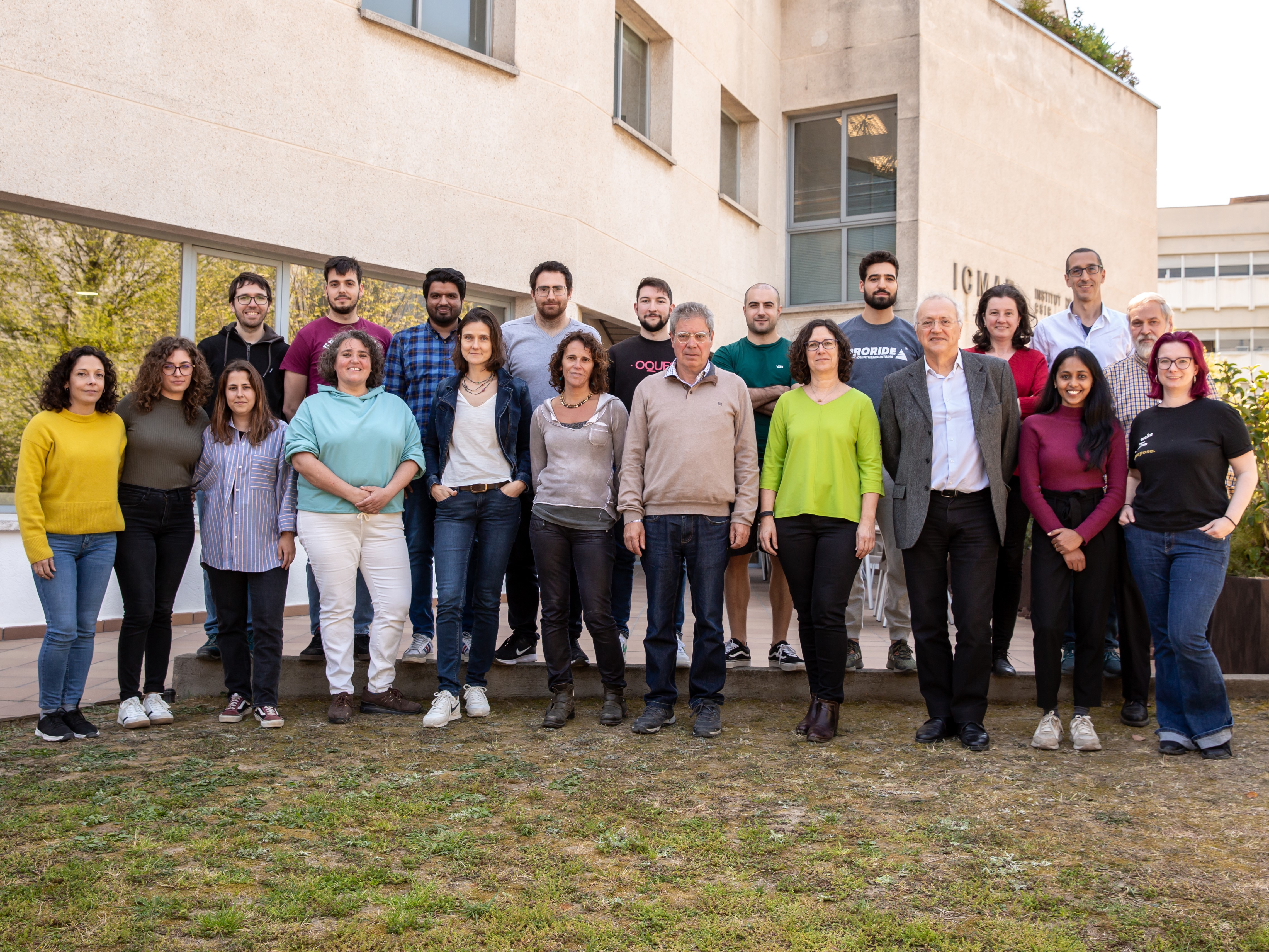 The scientific challenges and achievements of SUMAN comprise the areas of superconducting materials and functional oxide nanocoatings for the fields of energy transition, high energy physics and information -communication technology, as described below.
The scientific challenges and achievements of SUMAN comprise the areas of superconducting materials and functional oxide nanocoatings for the fields of energy transition, high energy physics and information -communication technology, as described below.Chemical solution deposition (CSD) has enable to demonstrate a novel high throughput TLAG-CSD method for high temperature superconducting film at ultrafast growth rates, with the help of in-situ XRD synchrotron experiments. We are evaluating the use of TLAG for fabricating superconducting joints. Furthermore, in combination with compositional gradient inkjet printing, TLAG is being used for fast materials design using machine learning algorithms
Superconductor Magnetic metasurfaces appears as a promising approach to efficiently control and guide magnetic fields at local scale. On-chip integrated metasurfaces face a very bright future for boosting the sensitivity and efficiency of magnetic sensors, magnetic harvesters and magnetic functional devices. Additionally, electromigration effects have been exploited for electric oxygen doping control of cuprates and manganites. And, we have continued studying other chemical methods like polymer assisted deposition (PAD) for thin films growth with dynamic magnetic and spin pumping properties.
In addition, we have placed superconducting coated conductors (CC) at the scene of future high energy circular accelerators, dark mater detectors for their low surface impedance properties at microwave frequencies, and nanocoated CC with current flow diverter architectures are now seriously considered also to protect high voltage dc grids.
Furthermore, CSD has demonstrated its versatility to prepare multifunctional complex oxides to be used in an all-oxide photovoltaic devices. The combination of CSD with a homebuilt atomic layer deposition reactor enabled the development of a cost-effective route to prepare freestanding multifunctional complex oxide membranes with atomic control facilitating the transition to crystalline and flexible devices.
HIGHLIGHTS
- The Cryogenic Materials Award for Lifetime Achievements 2023 is awarded to Prof. X. Obradors for advancing the knowledge of cryogenic materials.
- A plenary talk about an overview on progress, challenges and frontier research of coated conductors for applications is lectured by Prof. T. Puig at 16th European Conference on Applied Superconductivity (Bologna, Italy).
- DarkQuantum ERC-Synergy Grant is awarded and SUMAN will contribute to the advancement of quantum technologies for the search for dark matter axions.
- New precursor solution suitable for the preparation of high performance epitaxial REBa2Cu3O7-x superconductors is protected through an international patent (PCT/EP2023/070988).
-

SUSMOSYS
The newly formed Sustainable Molecular Systems Laboratory prepares and studies materials capable of capturing sunlight and converting it into useful energy.
We prepare chiral molecular materials for incorporation into solar energy capturing devices, mainly bulk heterojunction solar cells. Determining the organisation of these molecules in the films is challenging, as most techniques determine surface structure or bulk properties. Synchrotron based circular dichroism has been used in a novel way to observe the arrangement of the molecules in these films.
Another way to capture sunlight’s energy is in the form of photoswitchable materials that can store heat in their metastable forms. Triplet energy sensitization of switching has been used to control this process using bioplastics as a medium to ensure controllability and sustainability.
The stored solar energy can also be converted into electrical power using thermoelectric generators. This achievement was made using two photoswitches in a microelectromechanical chip, it has potential to transfer solar to electrical power without geographical restrictions.